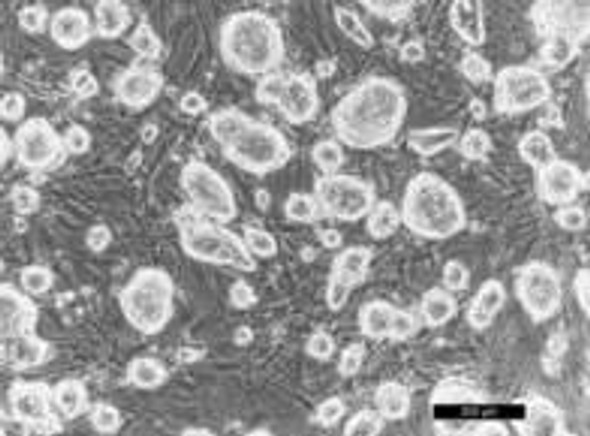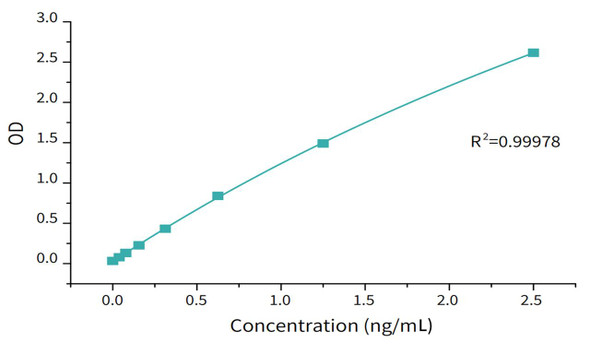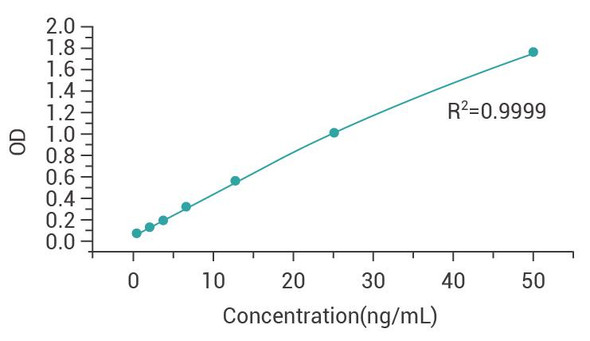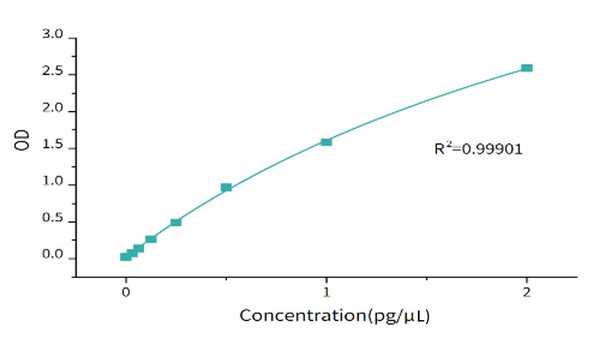Description
Overview
Key Advantages
| Rapid | Detect Mycoplasma in 1 hour by visual colour change! | |
| Simple | Add-Incubate-Detect protocol with results easily read by eye meaning no expensive equipment required. | |
| Sensitive | Detect as little as 500cfu Mycoplasma per 1ul of cell culture supernatant. | |
| Flexible | Detect 28 species of mycoplasma in adherent & suspensions cells such as Vero, MDCK, SP2/0, 293T, HepG2. HeLa, A549, MB-MDA231, L929, MEF, CHO, NS0, 293F, mouse hybridomas, Sf9, BHK21 & more. | |
| Compatible | With a wide selection of cell culture media & sera such as Fetal bovine/calf serum, horse serum, Gibco KSR serum replacement & CD FortiCHO, CDM4, Expi 293 Medium, CD Hybridoma, Grace, DMEM, 1640, F12 & more. |
Introduction
The MycoGenie Rapid Mycoplasma Detection Kit enables the rapid and simple detection of mycoplasma contamination in cell culture. This novel system detects mycoplasma in 1 hour from 1µl of cell culture supernatant by visual determination eliminating the requirement for PCR, qPCR, electrophoresis or ELISA. Compared with PCR, the MycoGenie Rapid Mycoplasma Detection Kit is more resistant cell culture inhibitors thus avoiding false positive and false negative results. The results are highly consistent with the most sensitive and accurate PCR kits for Mycoplasma detection.
The MycoGenie Rapid Mycoplasma Detection Kit can detect up to 28 mycoplasma species, including 8 of the most common species associated with cell culture contamination. It is suitable for mycoplasma detection in a wide range of suspension and adherent cells including CHO, Vero, hybridoma, Sf9, HEK293 and many more. Furthermore, the kit is compatible with a comprehensive suite of cell culture media and serum.
The MycoGenie Rapid Mycoplasma Detection Kit is an excellent choice for routine mycoplasma detection in biopharma, vaccine/monoclonal antibody production, cell therapy/embryo laboratories and other scientific research laboratories.
Visual Detection
Figure 1: Visual detection of Mycoplasma contamination using the MycoGenie Mycoplasma Detection Kit (MORV0011). Tube 1: Positive Control | Tube 2: Day 0 | Tube 3: Day 3 | Tube 4: Negative Control.
ES cultured cell cultures had no detectable Mycoplasma 3 days post-treatment with the with MycoPlasma Elimination Reagent (MORV0012).
Excellent Sensitivity
| Mycoplasma Copy No. | Visual Result Interpretation |
| 3.07x104 | +++ |
| 3.07x103 | ++ |
| 3.07x102 | + |
| 3.07x101 | - |
Table 1: The MycoGenie Rapid Mycoplasma Detection kit enables the detection of as little as 3.07x102 copies of Mycoplasma. This is more sensitive than in-house PCR analysis (3.07x103 copies) & the same as in-house QPCR analysis at 3.07x102 copies of Mycoplasma.
Kit Components
| Components | MORV0011 - 20 tests | MORV0011 - 50 tests |
| MycoGenie Buffer* | 480 µl | 1.2 ml |
| MycoGenie Enzyme | 20 µl | 50 µl |
| Positive Control | 10 µl | 25 µl |
| Paraffin Oil | 500 µl | 1.25 ml |
*Contains chromogenic reagent
Storage
Store at -20°C
Materials Required but Not Supplied
PCR instrument (heating function only), heated dry-bath or water bath.
Applications
MycoGenie Rapid Mycoplasma Detection Kit is suitable for many kinds of suspension and adherent cells with a wide range of media and serum compatibility. These include but are not limited to:
| Application | Example |
| Suspension cells | CHO, NS0, 293F, mouse hybridomas, Sf9, BHK21, etc. |
| Adherent cells | Vero, MDCK, SP2/0, 293T, HepG2. HeLa, A549, MB-MDA231, L929, MEF, etc. |
| Medium | CD FortiCHO, CDM4, Expi 293 Medium, CD Hybridoma, Grace, DMEM, 1640, F12, etc. |
| Serum | Fetal bovine/calf serum, horse serum, Gibco KSR serum replacement, etc. |
Protocol
1. Collect the Cell Culture Supernatant
Adherent cells: directly collect the supernatant. It is recommended to collect the sample 3 days after the cells were passed or the culture media was exchanged and there is a cell confluence of about 90%. Mycoplasma content in the supernatant is relatively high and easy to detect at this stage.
Suspension cells: centrifuge cells at 500 × g for 5 min and collect the supernatant. It is recommended to collect the sample 3 days after the cells were passed or the culture media was exchanged.
2. Preparation of Reaction Mixture
Thaw the MycoGenie Buffer and mix thoroughly. Prepare following reaction system in a microcentrifuge tube:
| Components | Volume for a Single Reaction |
| MycoGenie Buffer | 24 µl x Number of Samplesa x 1.1b |
| MycoGenie Enzyme | 1 µl |
*Note:
a. Set a negative control and a positive control for each experiment, if necessary.
b. The extra 10% volume of solution is necessary to ensure that sufficient quantities can be divided into each tube, due to pipetting errors.
3. Sample Addition
To each reaction mixture, add the following as per experimental design:
-
- Negative Control: Add 1 μl of sterile water as a negative control
- Experimental Samples: Add 1 μl of the cell culture media to be assayed
- Positive Control: Add 1 μl of the Positive Control (to be determined by end-user)
Mix thoroughly with a pipette or vortex.
*Note:
If the reaction is carried out in a water bath or PCR machine without heated lid, add 25 μl of Paraffin Oil to each tube to prevent liquid evaporation. When adding paraffin oil, change tips between samples to prevent cross-contamination.
4. Reaction
Incubate at 60℃ for 60 min in a PCR instrument, heated dry-bath or water bath.
*Note:
It is not recommended to use an oven for this reaction
5. Results
To determine the results, observe the color change in a bright environment and use white paper as a background.
Mycoplasma Negative Culture: Purple color solution
Mycoplasma Positive Culture: Sky blue color solution (as shown in figure on the right).
In rare circumstances (i.e. very low mycoplasma content), the color may be between purple and sky blue. In such cases, extend the reaction time to 75 min-90 min at 60℃ and observe the color again. The negative control or positive control can also be used as references.
*Note:
The reaction tube should never be reopened, due to possible false positives resulting from possible aerosol contamination.
Validation White Paper
At Assay Genie we have published a validation white paper titled "Validation of MycoGenie Rapid Mycoplasma Detection Kit". A summary of the white paper is given below but click the button to read the full PDF version!
Introduction
Mycoplasma contamination represents one of the greatest threats to cell culture integrity resulting in severe economic less for cell culture scientists in the bio-pharmaceutical industry. Mycoplasma have deleterious effects on cultured cells as they can compete for nutrients, alter ATP levels and elicit global changes in the gene expression profile among others. Research has shown that up to 85% of cell lines can be contaminated depending on the laboratory.
Therefore, with recent medical advances from vaccine & therapeutic antibody production to CAR-T therapies depending on vibrant cell culture processes, having a Mycoplasma-free cell culture remains paramount to optimised protein production.
Currently, methods to detect Mycoplasma include labour-intensive Quantitative PCR (qPCR) and luminescent-based approaches which are unsuitable for many laboratories & raise significant challenges for cell culture scientists.
However, the recently developed MycoGenie Rapid Mycoplasma Detection Kit enables the highly sensitive detection of 28 Mycoplasma species in under 1 hour from cell culture via a simple visual determination readout thereby eliminating the need for expensive equipment and time-consuming protocols.
In this study, we show that the limit of detection of MycoGenie Rapid Mycoplasma Detection kit is 3.07 x 102 copies of Mycoplasma which is similar to the “Gold Standard” qPCR method.
General Overview
The name Mycoplasma is derived from the Greek words mykes and plasma meaning "a fungus containing thread," and "a moldlike nature" and are the smallest bacteria known. They are implicated in human, animal, insect & plant diseases including AIDS, HIV and pneumoniae.
Mycoplasma contamination is a significant issue for cell culture scientists and can have a severe impact on protein production & cell health. They can be transmitted by aerosols from cultured cell lines, contaminated tissue, cultured media and biological waste such as carcasses, aborted fetal tissue and embryos that have been infected or not treated with antibiotics.
Mycoplasma contaminated cell cultures tend to be discarded which can result in a severe economic loss for the bio-pharmaceutical industry. Alternatively, scientists can use newly developed elimination reagents such as the Assay Genie MycoGenie MycoPlasma Elimination Kit that removes Mycoplasma without the need to discard precious cell lines and cultures.
Cell Culture Contamination
Mycoplasma-infected cells produce sub-optimal amounts of protein and increase the rate at which those cells die. Therefore, Mycoplasma contamination can reduce both the quantity and quality of protein produced by cultured cells.
Mycoplasma contamination can rapidly reach very high levels & infected cell culture monolayers often resemble tumour growth. These infected cell culture monolayers are often responsible for aerosolization of Mycoplasma and subsequent contamination of cell culture equipment, plasticware and cell lines.
Cultures of Mycoplasma are hard to maintain because they do not grow on traditional growth media such as blood or MacConkey agar. They require special nutrient media that may be used to grow Mycoplasma in vitro, but these cultures cannot be used to infect host cells unless cultured under stringent conditions that mimic the harshness of the hostile environment within which Mycoplasma grows best.
Mycoplasma can also contaminate laboratory rodents and research animals if Mycoplasma-free animals are not used. Mycoplasma can contaminate mice that have been genetically engineered to be deficient in or lack immune systems. Mycoplasma contamination can also arise if research animals are housed together with positive rodents (e.g., Mycoplastma pneumoniae, Mycoplastma suis, Mycoplastma ovis, etc.).
Assay Overview
Assay Genie MycoGenie Rapid Mycoplasma Detection Kit detects Mycoplasma in cell culture using a visual determination method. The kit utilises a highly sensitive isothermal amplification method coupled with a colorimetric readout that can detect up to 28 Mycoplasma species, including 8 of the most common species associated with cell culture contamination.
Results & Conlusion
View the full PDF version in order to access the results and conlusion of the white paper.
Troubleshooting
1. What is the sensitivity of the MycoGenie Rapid Mycoplasma Detection Kit?
The MycoGenie Rapid Mycoplasma Detection Kit is suitable for most cell culture experiments. It can accurately detect at least 500 cfu of mycoplasma from 1 μl of culture supernatant (5 × 105 cfu/ml). Typically, the mycoplasma content in culture supernatant is between 106 -108 cfu/ml. According to published literature, one single mycoplasma in cell culture can grow to 106 cfu/ml in 3-5 days. Therefore, it is highly recommended to detect after the third day after cell passage or after replacing media.
2. What to do if the detection color changes immediately after supernatant is added or different colors (not blue or purple) appear during the reaction?
In rare cases, ingredients in the media interfere with the color of the MycoGenie reagent. For example, Cell Boost 5 (Hyclone) makes the MycoGenie reagent appear pink. To avoid this:
(1) Collect a small amount of culture supernatant or cell suspension and centrifuge at 500 × g for 5 min. Collect the supernatant.
(2) Centrifuge again at high speed (> 12,000 × g) for 5 min to precipitate mycoplasma in the supernatant. Discard most of the supernatant and leave about 50μl in the tube. Add 950μl of sterile water and mix gently by pipetting.
(3) Repeat Step (2) for three times. Discard most of the supernatant and leave about 50μl in the tube.
(4) Take 1μl of supernatant for detection.
3. How to protect cells from mycoplasma contamination?
If mycoplasma contamination occurs, it is recommended to discard the cells to prevent other cells from contamination. If a mycoplasma positive result is detected, the same batch of cells should be discarded. Also, consider MycoGenie MycoPlasma Elimination Kit (Cat. No. MORV0012) as an excellent choice to remove mycoplasma from cell culture.
4. How to avoid false positives?
Generally, no false positives will occur during proper usage. The reaction tube should never be reopened, due to false positives resulting from aerosol contamination. Change tips between samples and always add the positive control last.
5. How many mycoplasma species can be detected by MycoGenie Rapid Mycoplasma Detection Kit?
There are 28 species of mycoplasma that can be detected accurately by MycoGenie Mycoplasma Detector:
| A. laidlawii* M. hominis* M. arginini* M. fermentans* M. hyorhinis* | M. salivarium* M. pirum* M. orale* A. granularum A. pleciae | M. neophronis M. timone M. caviae M. alvi M. bovis | M. primatum M. leopharyngis M. maculosum A. oculi M. iners | M. gallinarum M. sphenisci M. bovigenitalium M. auris M. columbinum | M. lipophilum M. falconis M. alkalescens |
* More than 95% mycoplasma contaminations in cell culture are caused by these 8 species.
Citation
| Membrez et al. | Trigonelline is an NAD+ precursor that improves muscle function during ageing and is reduced in human sarcopenia | Nature Metabolism 2024 | PubMed ID: 38504132 |
| Petropoulos et al. | Transcription-replication conflicts underlie sensitivity to PARP inhibitors | Nature 2024 | PubMed ID: 38509368 |
| Membrez et al. | Trigonelline is an NAD+ precursor that improves muscle function during ageing and is reduced in human sarcopenia | Nature metabolism 2024 | PubMed ID: 38504132 |
| Niall Browne et al. | The Impact of a Proprietary Blend of Yeast Cell Wall, Short-Chain Fatty Acids, and Zinc Proteinate on Growth, Nutrient Utilisation, and Endocrine Hormone Secretion in Intestinal Cell Models | Animals 2024 | PubMed ID: 38254407 |











